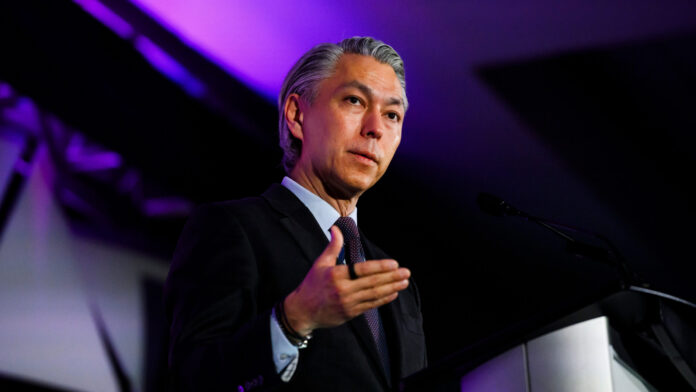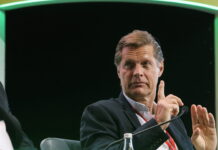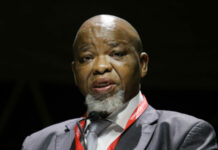
IT has been three years into a copper price bull run, yet it’s surprising how troubled some of its largest producers are. Rio Tinto, Anglo American and Glencore, accounting for 10% of global copper supply, are each in their own way wrestling with fundamental questions over portfolio and leadership.
Rio Tinto CEO Simon Trott announced a strategic review only three days into his tenure. He succeeded Jakob Stausholm, whose shock resignation in May was, according to media reports, rooted in a reluctance to discuss a merger with Glencore.
Rio’s board thinks the idea has enough merit to consider, as does the Swiss-based miner. Glencore CEO Gary Nagle recently made public his frustration with mining company valuation multiples, saying the largest miners were still too small to matter to generalist investors. Glencore abandoned a listing in New York because inclusion in the S&P 500 index couldn’t be guaranteed.
Anglo American’s plans to drastically streamline the business have run into headwinds. It successfully demerged its platinum unit, true, but an agreement to sell its metallurgical coal mines has been thrown into question after US miner Peabody Energy withdrew its offer. As matters now stand, the two are heading for arbitration.
Meanwhile, the sale of Anglo’s 85% stake in De Beers has been complicated by Botswana’s ambition to exercise its right of first refusal. In Brazil, Anglo faces an antitrust inquiry related to the recent sale of nickel assets. Then, on September 9, it unveiled a merger of equals with Canadian firm Teck – a transaction that has been broadly applauded. Both company boards have agreed to the deal but it will take upwards of a year to complete.
Set against this flux and existential questioning, and having recovered from its M&A dalliance with Anglo, BHP appears to have returned to a ‘business as usual’ position. “Defensive, reliable, strong,” said Tim Clark, an analyst for Standard Bank Group Securities, in a recent note.
Most of BHP’s big issues have already been tackled, such as the sale of its petroleum business and the change in its capital structure when it dispensed with a dual listing in London and Sydney. So the group doesn’t have a need for extensive surgery. It’s unsuccessful bid for Anglo last year has been criticised for its conditionality and apparent under-estimation of how South Africa felt about the loss of a corporate icon, yet that doesn’t appear to have unseated CEO Mike Henry.
Speaking to analysts at the group’s year-end results presentation in August, Henry said he was keen to stay on despite entering his sixth year as boss. “It feels like we got the basics right and a lot of the fun stuff is yet to come,” he added, referring to productivity improvements BHP hopes to unlock. BHP doesn’t have fixed-term contracts for its CEOs. On average the group’s leaders have stayed on for five to seven years, and some even longer.
The group produced decent year-end numbers. At 60 US cents a share, the final dividend declaration was in excess of policy (which would have been 50c), but more consequentially, it announced a $5bn increase in its net debt target range to $10-$20bn, described as “prudent” by Goldman Sachs analyst Matt Greene. He noted “the strong operating performance and focus on growth”.
Having failed to incorporate Anglo’s 750,000 tons a year in copper output, BHP has responded by casting the spotlight on its organic growth. In addition to South Australia Copper and Resolution, a copper project in Arizona, the group expects to conclude a study on the Vicuña project in Argentina in the first quarter. Vicuña was acquired in last year’s C$1.4bn takeover of Filo Corp with Lundin Group.
“We think investors have been somewhat wary since BHP’s attempted takeover of Anglo last year,” said Clark. However, BHP’s strong investment focus and the higher net debt range “will support a rerating”.
In the absence of a rerating, don’t expect any mergers & acquisitions, added Clark. Despite pitching for Anglo, BHP is generally sceptical of M&A. There is an argument that once you go over a market cap of about $10bn, mining companies don’t get a better multiple by being bigger.
Of course, BHP has its deficits. It has delayed the implementation of the second phase of its Jansen potash mine in Canada after a cost blowout. Iron ore price weakness is another threat, especially given nearly $1bn in capital equipment replacements at Western Australia Iron Ore.
Benchmark iron ore prices decreased slightly to $101 a ton in the first half of this year compared with $102 a ton in the second half of last year. Though this contributed towards an average 7% reduction in the average earnings before interest, tax, depreciation and amortisation of five of the largest iron ore producers (including Rio, Vale, Anglo and Fortesque), BHP performed relatively well. “BHP stands out as the highest-margin producer of the group, followed by Rio,” says UBS analyst Myles Allsop.
A version of this article first appeared in the Financial Mail.











